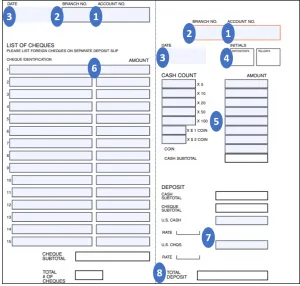 BMO Performance Chequing Account
BMO Performance Chequing Account
Bank deposit slips are used to add cash or cheques to your chequing or savings accounts. It only takes a couple of minutes to fill out — but most banks will let you deposit cheques through a mobile banking app if you’d rather skip it altogether.
What is a deposit slip?
A bank deposit slip can be used to add funds to your bank account. You can deposit cash and cheques on the same deposit slip. Most banks will also let you request to withdraw cash from a cheque you’re depositing on the slip.
Deposit slips can be used at a bank branch or at certain ATMs. If you’re depositing a cheque or cash at an ATM, check that the ATM accepts deposits and whether you’ll need an envelope to keep your deposit slip and money together.
 BMO Performance Chequing Account
BMO Performance Chequing Account
How do I fill in a deposit slip?

Completing a deposit slip may require that you provide:
- Account number. Enter the account number where you want the money deposited. You may need to enter it on both the cheque and cash sides of the slip. If you’re not sure what your account number is, you can find it on one of your own cheques, through your bank’s online banking platform or by asking a bank teller. If you want more information on what information is included on a blank cheque or how to properly fill one out, check out our other article.
- Branch (Transit) Number. You should be able to find your branch number near the account number at the bottom of your cheque, in your online banking account or by asking a teller.
- Date. Use the date you’re making the deposit on, not the date on the check.
- Initials. Depending on your bank, you may be required provide your name, initials and signature.
- Cash. Enter the amount of cash you’re depositing, including change. Like in the example above, you may have to enter the number of each type of bill and coin under the Cash Count column. In the Amount column you would write the total value for each type of bill or coin. For example, if you were depositing three $5 bills, you would write 3 under Cash Count and $15.00 under Amount. Then, enter the total amount in both Cash Subtotal lines by adding up all of the bills and coins.
- Cheques. Write the value of each cheque in the Amount column on separate lines. Under the Cheque Identification column write the cheque number. The cheque number is a unique identifying number printed on every cheque in a cheque book. It’s usually printed in the upper right corner of the cheque and as the first set of numbers along the bottom. Add up the total amount of all cheques to write in both Cheque Subtotal lines.
- US Cash or Cheques. Your deposit slip may give you the option to deposit US cash or cheques. Like in the example slip above, you would need to write the total value of US cash and US cheques in the appropriate lines. You can also include the exchange rate in the Rate line.
- Total deposit. Write the total amount you’re depositing into your bank account on the line / in the box at the bottom by adding up all cash and cheques.
Mobile phone deposits
Many banks allow customers to deposit cheques online or by using your mobile banking app. The processes will be slightly different depending on which bank your with.
Personal deposits
You may be able to deposit cheques into your personal account via your bank’s mobile app. You’ll generally need to take pictures of the front and back of your cheque using your phone when prompted. Check with your bank to find out if you’re bank offers mobile deposits through their app.
Business deposits
If you regularly deposit cheques for your business, you may be able to deposit electronically using a cheque scanner. Check with your bank to find out if your business is eligible and how to get started.
If you’re depositing cash, you’ll still need to do it in person — though some bank branches offer night deposit boxes for after-hours deposits.
Some banks let their business account holders make use of express deposits. To make these deposits you may have to use business deposit slips, like the one in the example above. Your bank will likely provide you with a business express deposit envelope that you can use to make the required deposit. Place the deposit in the envelope and seal it. Make a note of the deposit details outside the envelope. Tear off any receipt that you get to keep. Deposit it using any given method.
Bottom line
Depositing cash or checks into your bank should be simple, but the deposit slips and electronic options can vary from bank to bank. If you make regular deposits, talk with your financial institution about the most efficient way to handle your finances. And if you’re looking for a new bank, compare banks to find one that’s the right fit for you.
Frequently asked questions
More guides on Finder
-
45 tips for how to save money in Canada
Your guide to saving money on gas, groceries, utilities and everyday expenses in Canada.
-
Banking statistics and trends in Canada for 2025
Explore key banking statistics and figures from the Finder: Consumer Sentiment Survey January 2025.
-
The best banks in Canada for 2025
We compare Canada’s best banks to help you find your perfect banking match.
-
Scotiabank promotions and offers
Explore all the latest Scotiabank promotions and offers available now.
-
Beacon Money Account review
Your guide to features and fees of the Beacon Money Account for newcomers to Canada.
-
Alternatives to Tangerine Bank
Your guide to the 6 of the best Tangerine alternatives in Canada.
-
15 best new bank account offers for April 2025
Earn cash, rewards points, bonus interest rates and more with these new bank account offers and promotions.
-
Bank of Canada interest rate forecast report
Read Finder’s BoC Interest Rate Report for forecasts from some of Canada’s brightest minds in economics and learn more about how recent rate increases could affect Canada’s real estate market.
-
Compare bank interest rates
From mortgages to high-interest savings accounts, here’s how to find the best interest rates in Canada.
-
Open a bank account online in Canada in 5 easy steps
Compare and open a bank account online in Canada in as little as 5 minutes. Learn what you need to apply and how to get started today.

